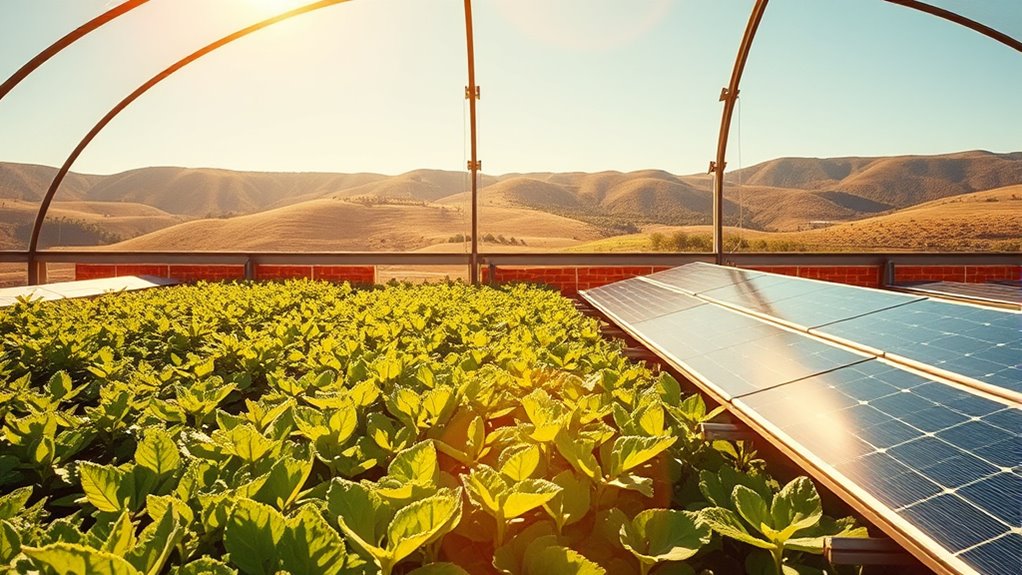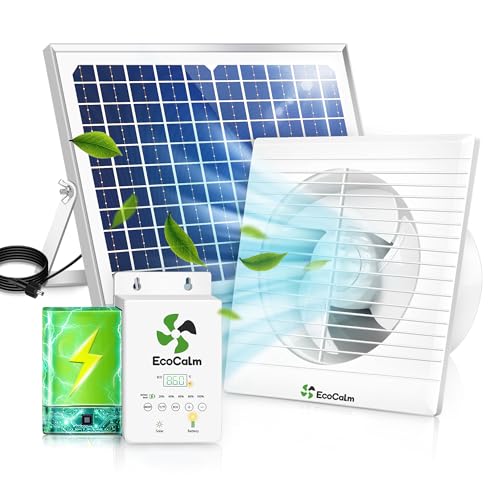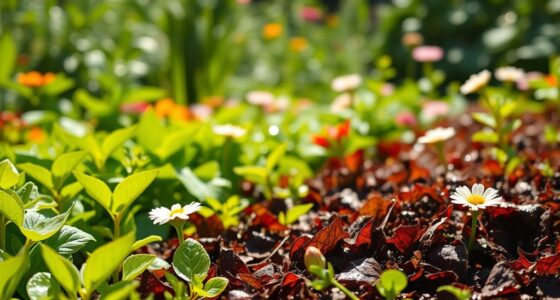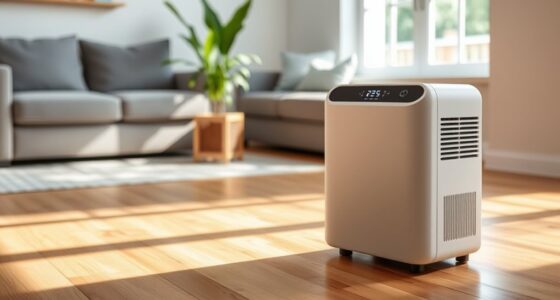When I think about powering my greenhouse sustainably, the right solar panels are essential. The Renogy Bifacial 450 Watt panels are great with their impressive energy output. I love their durability in snowy conditions too. The ECO-WORTHY 400W setup is budget-friendly and perfect for DIY projects. Also, the solar-powered fans keep the air circulating. You'll find more about these options and factors to take into account when choosing the best solar panels for your plants.
Key Takeaways
- Choose solar panels with high efficiency ratings (above 20%) to maximize energy production for greenhouse operations.
- Consider lightweight and compact panels for easier installation and optimal space utilization in greenhouse environments.
- Look for durable materials that withstand harsh weather conditions, ensuring long-term performance and reliability.
- Evaluate warranty options and customer support services to ensure assistance and protection for your investment.
- Assess your greenhouse's orientation and shading to determine the best panel placement for maximum sunlight exposure.
Renogy Bifacial 450 Watt Solar Panels (2 Pack)
If you're looking for powerful and efficient solar panels to optimize energy production in your greenhouse, the Renogy Bifacial 450 Watt Solar Panels (2 Pack) might be just what you need. These monocrystalline panels boast a maximum power output of 450 watts and can yield up to 30% more energy than traditional models. Their innovative design enhances performance even in partial shade and during snowy conditions. Weighing 50.9 pounds and featuring a robust 25-year performance warranty, they're perfect for off-grid applications. Just keep in mind the mixed reviews on customer service, as some users have encountered issues.
Best For: Those seeking efficient solar energy solutions for off-grid applications like greenhouses, rooftops, farms, and yachts.
Pros:
- Bifacial design can yield up to 30% more energy compared to traditional solar panels.
- Enhanced performance in partially shaded conditions with advanced technologies like PERC and half-cut cells.
- Robust 25-year performance warranty ensures long-term reliability and investment value.
Cons:
- Mixed reviews on customer service, with some users reporting issues during warranty claims.
- Concerns about shipping damage, with instances of panels arriving scuffed or shattered.
- Some users experienced product defects that affected overall satisfaction.
Renogy 200 Watt 24V Solar Panel
The Renogy 200 Watt 24V Solar Panel stands out as an excellent choice for greenhouse enthusiasts seeking reliable energy solutions. With its advanced 16BB cell technology, this panel boasts a remarkable 25% efficiency, ensuring peak power generation even in cloudy conditions. Weighing just 24 pounds and measuring 49.7 by 30.1 inches, it's compact enough for tight spaces. I appreciate its durability, built from tempered glass and aluminum, and the long-term reliability with minimal degradation. Plus, the 10-year warranty gives me peace of mind. If you're looking for dependable performance, this panel won't disappoint in powering your greenhouse sustainably.
Best For: Greenhouse enthusiasts and off-grid users seeking a reliable and efficient solar energy solution.
Pros:
- High efficiency rated at 25% ensures optimal power generation even in cloudy conditions.
- Durable construction with tempered glass and aluminum for long-lasting performance.
- Compact and lightweight design makes it ideal for tight spaces in RVs, vans, and greenhouses.
Cons:
- Limited to 200 watts, which may not be sufficient for larger energy needs.
- Requires compatible battery systems (12V or 24V) for optimal performance.
- Installation may require additional hardware if not using existing mounts.
ECO-WORTHY 400W Solar Panels (4pcs 100 Watt Monocrystalline)
For budget-conscious gardeners looking to harness solar energy, the ECO-WORTHY 400W Solar Panels stand out as an excellent choice. With four 100-watt monocrystalline panels, they offer a daily output of 1600Wh, perfect for various applications like greenhouses and RVs. Their durable design withstands high winds and heavy snow while ensuring reliable performance. I appreciate the user-friendly installation with pre-drilled holes and plug-and-play connectors. Despite some minor issues reported, like broken clips, I found these panels to be a fantastic value, especially when purchased on sale. They're a great option for anyone wanting to experiment with solar power!
Best For: Budget-conscious consumers looking for reliable solar solutions for gardening, RVs, or DIY projects.
Pros:
- Durable design withstands high winds and heavy snow loads, ensuring longevity.
- User-friendly installation with pre-drilled holes and plug-and-play connectors simplifies setup.
- Excellent value for performance, especially when purchased on sale, with high daily output.
Cons:
- Some users reported issues with broken clips or defective panels, affecting overall satisfaction.
- Customer service experiences varied, with reports of difficulties in handling returns.
- Flimsy framing compared to higher-end brands may raise concerns about long-term durability.
ECO-WORTHY 200 Watts Solar Panel Kit for RV and Off Grid Applications
Looking for a reliable solar solution for your greenhouse? The ECO-WORTHY 200 Watts Solar Panel Kit is a fantastic choice. With its high-efficiency monocrystalline panels, it generates up to 800Wh per day under ideal sun conditions. The kit comes with everything you need: two 100W panels, a 30A PWM charge controller, and pre-drilled cables for easy installation. Plus, its corrosion-resistant frame guarantees durability in various weather conditions. Rated 4.5 out of 5 stars by users, it's perfect for off-grid applications, powering devices like fans and lights. This kit can be your perfect starter system for sustainable energy!
Best For: Those looking for a reliable and efficient solar power solution for off-grid applications, such as RVs, cabins, and greenhouses.
Pros:
- High-efficiency monocrystalline solar panels that generate up to 800Wh per day under optimal conditions.
- Complete kit includes all necessary components for easy installation, including pre-drilled cables and a 30A charge controller.
- Durable construction with a corrosion-resistant aluminum frame, ensuring longevity and performance in various weather conditions.
Cons:
- Limited to generating power based on sunlight availability; performance may decrease on cloudy days.
- Requires knowledge of solar system installation for optimal setup; beginners may need additional guidance.
- The kit may not fully power larger appliances without additional battery storage or multiple kits.
Renogy Solar Panel 100 Watt 12 Volt for Off-Grid Applications
Renogy's 100 Watt 12 Volt solar panel stands out as an exceptional choice for anyone seeking reliable off-grid power solutions, especially for greenhouse applications. With high-efficiency monocrystalline cells and a compact design, it weighs only 14.1 lbs, making installation a breeze. I love that it averages 500Wh per day, even under cloudy conditions. Plus, its durable construction guarantees it can withstand harsh weather. The 20 pre-drilled holes simplify mounting, and users often report exceeding the rated wattage. At a price of around $62, it offers great value for sustainable energy. I highly recommend it for anyone looking to power their plants efficiently.
Best For: Individuals seeking a reliable and efficient solar panel solution for off-grid applications, particularly in greenhouse settings.
Pros:
- High-efficiency monocrystalline cells provide up to 22% efficiency, ensuring optimal energy output.
- Durable construction with IP65 protection allows for all-weather performance and longevity.
- Easy installation with 20 pre-drilled holes and compatibility with various mounting options.
Cons:
- Some users have reported issues with connectors, requiring workarounds for optimal performance.
- Performance can vary based on the type of MPPT charge controller used, potentially affecting output.
- While priced competitively, initial investment may be higher than some less reliable alternatives.
Solar Panel Powered Fan Kit for Greenhouse
A standout feature of the Solar Panel Powered Fan Kit is its impressive air-flow capacity of up to 360 CFM, making it an excellent choice for greenhouse enthusiasts like myself who want to maintain ideal temperatures for their plants. With a 20W solar panel and dual exhaust fans, installation is a breeze—taking about half an hour. I love that it's IP67 waterproof, so I don't worry about rain. While it runs on solar power, I've noticed it works great, even on cloudy days. Just be mindful of placement, as performance dips in shaded areas. Overall, it's a reliable, eco-friendly option!
Best For: Greenhouse enthusiasts and off-grid users seeking an eco-friendly ventilation solution for maintaining optimal temperatures for plants and animals.
Pros:
- Easy installation, typically taking about half an hour with all necessary components included.
- IP67 waterproof design allows for reliable outdoor use in various weather conditions.
- Effective air circulation even on cloudy days, providing a sustainable cooling option.
Cons:
- Performance heavily depends on sunlight; less effective in shaded areas.
- May not provide sufficient power for larger spaces or specific ventilation needs.
- Reports of quality control issues with some units having missing parts upon delivery.
EF ECOFLOW Solar Generator DELTA2 with 220W Solar Panel
For those seeking a reliable power solution for their greenhouse, the EF ECOFLOW Solar Generator DELTA2 with its 220W solar panel stands out due to its impressive battery technology and capacity. With a powerful LiFePO4 battery that boasts over 3000 cycles, it provides 1024 watt-hours of energy. I love the rapid charging feature, allowing me to reach 80% in just 50 minutes. Plus, it supports a variety of devices with 15 outlets, including USB-C and AC ports. The mobile app control adds convenience, making it easy to monitor and manage my energy needs from anywhere.
Best For: Those seeking a reliable and efficient power solution for off-grid applications, including camping, outdoor events, and greenhouse energy needs.
Pros:
- Rapid Charging: Reaches 80% charge in just 50 minutes, making it quick to power up.
- High Capacity and Expandability: Base capacity of 1kWh, expandable to 3kWh for increased energy needs.
- Versatile Power Outlets: Features 15 outlets, including USB-C and AC, suitable for various devices.
Cons:
- Weight: At 58 pounds, it may be cumbersome for some users to transport.
- Fan Noise: Can be notable during rapid charging, which might be distracting in quiet environments.
- Price Point: May be more expensive compared to traditional generators with lower specifications.
Large Solar Powered Exhaust Fan for Greenhouse
If you're looking to enhance ventilation in your greenhouse, the Large Solar Powered Exhaust Fan is an ideal choice. With its robust 20W solar panel and 2400 CFM airflow, it keeps your plants cool and healthy. I appreciate that it operates on solar energy during the day and can use a DC cable at night. Installation is simple, thanks to the adjustable bracket and secure mounting options. While some users mention noise and durability concerns, the overall performance in hot conditions is impressive. Plus, the responsive customer support adds peace of mind. It's a solid investment for any greenhouse setup!
Best For: Greenhouse owners seeking an efficient and eco-friendly ventilation solution for their plants.
Pros:
- Operates on solar energy during the day, ensuring sustainable energy use.
- High airflow capacity of 2400 CFM effectively cools greenhouse spaces.
- Easy installation with adjustable brackets and secure mounting options.
Cons:
- Some users report concerns about noise levels during operation.
- Durability issues noted, with some fans failing after a few months.
- Lightweight plastic casing may not withstand harsh conditions over time.
8 Inch Solar Fan with Solar Panels for Ventilation and Cooling
The DELUMEE 8 Inch Solar Fan with its two solar panels is an ideal choice for anyone looking to enhance ventilation in greenhouses or outdoor spaces. This fan packs a punch with its 25W power, ensuring reliable airflow even on cloudy days. I love that it features a quiet brushless motor and a sturdy design that's safe for any environment. With a service life of up to 8,000 hours, it's built to last. Plus, the included A-grade solar panels make it easy to harness the sun's energy. Installation is a breeze, making it a must-have for sustainable cooling.
Best For: Individuals seeking an eco-friendly ventilation solution for greenhouses, pet houses, chicken coops, or outdoor camping.
Pros:
- Powerful airflow generated by dual solar panels, ensuring performance even on cloudy days.
- Quiet operation due to the ball bearing brushless DC motor, making it suitable for noise-sensitive environments.
- Easy installation with a foldable support and ample 14ft power cord for flexible placement.
Cons:
- Limited to outdoor usage due to the solar panel dependency.
- Performance might be affected by extreme weather conditions or prolonged cloud cover.
- Requires adequate sunlight for optimal efficiency, which may not be suitable for all locations.
Solar Exhaust Fan for Shed (25W Solar Panel)
Looking for an efficient way to ventilate your shed while harnessing solar energy? The Solar Exhaust Fan with a 25W solar panel is an excellent choice. With its 8-inch blades and a 2600 RPM motor, it delivers impressive airflow while maintaining a low noise level of just 36 decibels. The durable ABS construction and IP67 rating guarantee it withstands outdoor conditions. Plus, it operates even on cloudy days, thanks to the included AC to DC adapter. Installation is straightforward, requiring minimal tools. Users appreciate its effectiveness in high-temperature environments, making it a perfect addition to any shed.
Best For: Those looking for an eco-friendly and efficient ventilation solution for their shed, particularly in high-temperature environments.
Pros:
- Durable construction with ABS material and IP67 rating for dust and water resistance.
- Impressive airflow with an 8-inch fan and 2600 RPM motor while maintaining a low noise level of 36 decibels.
- Easy installation with included components and minimal tools required.
Cons:
- No built-in battery, limiting operation to daylight hours unless using the AC to DC adapter.
- Some noise may occur during operation, potentially linked to the mounting surface.
- User suggestions for improvements include adding a temperature-controlled switch and addressing flap vibrations.
Solar Fan with Battery and 25W Bifacial Solar Panel
For anyone managing a greenhouse or similar space, the Solar Fan with Battery and 25W Bifacial Solar Panel stands out as a top choice due to its impressive ability to provide ventilation even during the night. With a 3000mAh rechargeable battery, it runs for up to 8 hours after a full charge. Its 25W bifacial solar panel boosts efficiency, generating power from both sides. I appreciate its easy installation and versatility across various environments. While some users mention durability concerns, the fan's airflow and intelligent operation make it a solid option for maintaining a comfortable climate for my plants.
Best For: The Solar Fan with Battery and 25W Bifacial Solar Panel is best for greenhouse managers and individuals looking for an efficient ventilation solution that operates both day and night.
Pros:
- Efficient Power Generation: The bifacial solar panel increases power generation efficiency by 130%, providing reliable ventilation.
- Versatile Installation: Easy to install in various locations such as attics, barns, and garages, making it suitable for multiple applications.
- Nighttime Operation: The rechargeable battery allows the fan to run for up to 8 hours after a full charge, ensuring continuous airflow.
Cons:
- Durability Issues: Some users report concerns about flimsy construction and rusting screws, which may affect long-term use.
- Battery Performance: Battery life can vary, with reduced operational times on cloudy days, leading to potential gaps in ventilation.
- Manual Restart Required: If the battery dies, a manual restart is necessary, which can be inconvenient for unattended spaces.
SUNGOLDPOWER 550W Solar Panels (2PCS, Monocrystalline)
SUNGOLDPOWER 550W Solar Panels stand out as an excellent choice for greenhouse enthusiasts who prioritize efficiency and durability. With a total power output of 1100W from two monocrystalline panels, they're perfect for various applications, including off-grid solar systems. I love their waterproof IP68 rating and scratch-resistant aluminum frame, ensuring they withstand outdoor conditions. Plus, installation is a breeze with pre-drilled holes. The impressive efficiency, backed by a solid warranty, gives me peace of mind. Customers rave about the 5-star support, making these panels a reliable option to power my greenhouse sustainably.
Best For: Greenhouse enthusiasts and individuals looking for efficient, durable solar power solutions for off-grid applications.
Pros:
- High total power output of 1100W from two monocrystalline panels.
- Robust waterproof design (IP68) and scratch-resistant aluminum frame for durability in outdoor conditions.
- Easy installation process with pre-drilled holes, complemented by excellent customer support.
Cons:
- Relatively heavy at 56.9 pounds, which may complicate installation for some users.
- Limited to 30-day return period, which may not be sufficient for thorough testing.
- Best suited for specific applications, potentially limiting versatility for some users.
Solar Fan with Battery for Shed and Greenhouse
If you're seeking an efficient way to keep your greenhouse or shed cool, the Solar Fan with Battery is an excellent choice. This fan is powered by a 25W solar panel and features a rechargeable 6000mAh battery, giving you 10-14 hours of operation. I love how the intelligent power supply adjusts based on sunlight, ensuring peak performance. It's compact and lightweight, making installation easy with adjustable brackets. The high-speed dual fans provide great airflow while remaining quiet. However, some users report performance issues during low sunlight. Overall, it's a solid option to enhance ventilation in your growing spaces.
Best For: Those looking to enhance ventilation in greenhouses, sheds, or chicken coops with an eco-friendly solar-powered solution.
Pros:
- High-speed dual fans provide effective airflow while operating quietly.
- Rechargeable battery allows for 10-14 hours of operation after a full charge.
- Adjustable solar panel mount ensures optimal sunlight exposure for better performance.
Cons:
- Some users report inadequate battery charging during low sunlight conditions.
- Performance may be limited to direct sunlight, affecting nighttime operation.
- Mixed customer reviews regarding overall effectiveness and reliability.
5.5 Inch Solar Powered Fan Kit with 25W Solar Panel
The 5.5 Inch Solar Powered Fan Kit with a 25W Solar Panel is an excellent choice for anyone looking to enhance air circulation in their greenhouse or shed. This kit includes two waterproof fans and a powerful solar panel, ensuring efficient airflow with velocities up to 3500 RPM. I love the flexibility of its installation options, allowing for different configurations to suit my needs. Plus, the IP67 waterproof rating gives me peace of mind in outdoor conditions. While performance can dip in cloudy weather, I've found it effective for maintaining ventilation in small spaces. Overall, it's a fantastic addition to my setup!
Best For: Individuals seeking an eco-friendly ventilation solution for small outdoor spaces like greenhouses, chicken coops, or sheds.
Pros:
- High airflow performance with fan speeds up to 3500 RPM, ideal for effective ventilation.
- Flexible installation options allow for various configurations to meet specific needs.
- Durable and waterproof design (IP67 rating) ensures reliable operation in outdoor conditions.
Cons:
- Performance may decline in cloudy or rainy weather, limiting effectiveness during such conditions.
- Power loss can occur when multiple fans are connected, potentially reducing overall efficiency.
- Limited to small spaces, which may not be suitable for larger areas requiring ventilation.
Solar Powered Exhaust Fan Kit for Outdoor Use
For anyone looking to enhance ventilation in their greenhouse or similar outdoor space, the Solar Powered Exhaust Fan Kit is an excellent choice. With a 20W solar panel and two powerful 5-inch fans, it effectively removes heat, odors, and dust, rotating at up to 3500 RPM. I love that it's IP66 waterproof and performs well in various temperatures, ensuring durability. Installation's a breeze with clear instructions and flexible positioning options. Just remember, it works best in direct sunlight, so keep it in an open area. Overall, it's a reliable solution for maintaining ideal airflow in your outdoor spaces.
Best For: Those seeking an eco-friendly ventilation solution for small outdoor spaces like greenhouses, chicken coops, or sheds.
Pros:
- Powerful airflow with two 5-inch fans reaching up to 3500 RPM.
- IP66 waterproof rating ensures durability against rain and outdoor conditions.
- Easy installation with clear instructions and flexible fan positioning options.
Cons:
- Performance may be diminished in shaded areas with limited sunlight.
- Lacks battery backup, ceasing function when sunlight is unavailable.
- Some users report potential rust on fan grates over time.
Factors to Consider When Choosing Solar Panels for Greenhouses

When I'm choosing solar panels for my greenhouse, I focus on a few key factors. Energy output efficiency, durability, and installation ease are critical to guarantee I get the most out of my investment. I also consider the space I have available and my budget to make the best decision for my needs.
Energy Output Efficiency
Choosing the right solar panels for your greenhouse involves considering energy output efficiency, which is essential for maximizing your investment. High-efficiency models can convert over 25% of sunlight into electricity, making them a smart choice. I often recommend monocrystalline panels; they typically provide better efficiency than polycrystalline ones, especially in limited spaces like greenhouses. Additionally, advanced technologies like bifacial panels can capture sunlight from both sides, potentially boosting output by up to 30%. Keep an eye on temperature coefficients too; panels with lower coefficients perform better in hot conditions. Finally, regularly check for shading and guarantee ideal placement, as even partial shading can greatly reduce energy output. This way, you'll truly harness the sun's power for your plants.
Panel Durability and Weather Resistance
Since your greenhouse will be exposed to varying weather conditions, it's important to prioritize panel durability and weather resistance. I recommend looking for solar panels with an IP rating of at least IP65, guaranteeing protection against dust and water. Panels made from tempered glass and corrosion-resistant aluminum frames offer enhanced durability, standing up to extreme temperatures and high winds. If you live in an area with heavy snowfall, check that the panels can handle snow loads rated in Pascals, like 5400Pa, to prevent damage. Additionally, consider panels with a low temperature coefficient for better performance in high heat, maintaining efficiency even in hot greenhouse conditions. Rigorously tested panels will provide reliability and a longer service life.
Installation and Setup Ease
Installing solar panels in your greenhouse can be a breeze if you keep a few key factors in mind. First, look for models with pre-drilled holes and plug-and-play connectors; they'll save you time during setup. I recommend choosing kits that include all necessary components, like mounting brackets and cables, so you won't need to make extra purchases. Lightweight panels are also a smart choice because they're easier to handle, especially in elevated spots. Additionally, flexible mounting options let you adjust the angle to maximize sunlight exposure. Finally, make certain to select panels with a weather-resistant rating to guarantee durability and reliable performance, regardless of the environmental conditions. Trust me; these considerations will simplify your installation process considerably.
Size and Space Considerations
When it comes to solar panels for your greenhouse, size and space considerations play an essential role in guaranteeing ideal energy generation. First, I assess the available roof or ground space to determine how many panels fit without compromising structural integrity or plant areas. I also consider the dimensions of the solar panels; larger panels can generate more power but need more space, which may limit placement. It's vital to evaluate the angle and orientation of my greenhouse to maximize sunlight exposure, as this affects efficiency. I calculate my total power requirements to confirm the chosen panels meet my energy needs. Finally, I factor in potential shading from nearby trees or structures, as even partial shading can greatly reduce output.
Cost and Budget Constraints
While managing the costs associated with solar panels for my greenhouse, I find it essential to weigh both initial investments and long-term savings. The initial cost can vary widely depending on the panel type and wattage, so I keep my budget in mind. I look for panels with efficiency ratings above 20%, as they maximize energy production per square foot, ultimately lowering costs over time. Installation expenses can add up, but I prefer panels with pre-drilled holes to save on labor. Additionally, I consider potential savings on electricity bills and incentives like tax credits that enhance my return on investment. Finally, investing in durable panels with solid warranties can reduce future replacement and maintenance expenses.
Maintenance and Longevity
After carefully considering costs and budget constraints, I recognize that maintenance and longevity are vital factors in choosing solar panels for my greenhouse. Regular maintenance, like cleaning and inspections, guarantees peak performance and extends the life of my panels. I've learned that high-quality solar panels typically last 25 to 30 years, often with warranties guaranteeing at least 80% efficiency after 25 years. Choosing panels made from durable materials, such as tempered glass and corrosion-resistant frames, helps them withstand harsh weather conditions. With low degradation rates, often below 0.5% annually, these panels maintain efficiency over time. Proper installation is essential too, as it can greatly enhance their lifespan by reducing wear and improving energy capture.
Versatility for Various Applications
Choosing solar panels for my greenhouse isn't just about maximizing energy for my plants; it's also about their versatility across various applications. I've found that solar panels can power everything from RVs and boats to cabins, making them a smart investment. Many models are designed for off-grid use, which is perfect for remote areas lacking traditional power sources. High-efficiency options, like those with PERC cell technology, still generate power in cloudy conditions, enhancing their usability. Plus, integrating solar panels can improve air circulation with solar-powered fans, benefiting plant health. I'm particularly excited about bifacial solar panels, which can boost energy yield by up to 30%, giving me even more flexibility in energy generation for my greenhouse and beyond.
Warranty and Support Options
When investing in solar panels for my greenhouse, I know that warranty and support options play an essential role in ensuring long-term satisfaction. A longer warranty period, like a 25-year performance warranty, offers reassurance about durability and efficiency, making it a smart investment. I always check the warranty terms to understand what defects are covered and any exclusions that might affect my coverage. Additionally, I look for manufacturers that provide customer support, such as 24/7 technical assistance, to help resolve any issues quickly. A satisfaction guarantee or return policy can also give me peace of mind. Finally, I read reviews about customer service experiences to gauge the reliability of support options, which is critical for handling warranty claims effectively.
Frequently Asked Questions
How Do I Determine the Right Solar Panel Size for My Greenhouse?
To determine the right solar panel size for my greenhouse, I start by calculating my energy needs. I look at the total wattage of the equipment I plan to use. Then, I consider the average sunlight hours my location receives. Using this information, I can estimate the total wattage needed and divide it by the wattage of the solar panels I'm considering. This way, I make certain I'm getting enough power for my plants.
Can Solar Panels Work Efficiently in Cloudy Weather?
When it comes to solar panels, I've learned that they can still shine like a beacon in cloudy weather. While their efficiency drops compared to sunny days, they can still generate power; I've seen it firsthand. Many modern panels are designed to capture diffuse sunlight, so don't worry too much about overcast skies. Just keep the panels clean and well-positioned, and you'll see decent energy production even when the sun's hiding.
What Maintenance Do Solar Panels Require in a Greenhouse?
Maintaining solar panels isn't overly complicated, but it's crucial for efficiency. I regularly check for dirt, debris, or snow that can obstruct sunlight. Cleaning them a couple of times a year keeps them functioning well. I also inspect the wiring and connections for any wear or damage. Finally, monitoring their performance helps me spot any issues early on. With just a little effort, I guarantee my solar panels stay in top shape.
Are There Any Tax Incentives for Installing Solar Panels?
Installing solar panels is like planting seeds for a brighter future. There are indeed tax incentives for installing solar panels that can really help offset initial costs. I've found that federal tax credits often cover a significant portion of the installation expense, and some states offer additional rebates. It's worth checking local programs, as they can vary. Taking advantage of these incentives makes going solar even more appealing for everyone!
How Long Do Solar Panels Typically Last?
When I think about solar panels, I often wonder how long they actually last. Typically, solar panels can last anywhere from 25 to 30 years, depending on the brand and maintenance. I've found that most manufacturers offer warranties around this time frame, which gives me peace of mind. Regular cleaning and inspections can also help extend their lifespan, so I make sure to keep an eye on mine for peak performance.
Conclusion
To sum up, choosing the right solar panels for your greenhouse can truly be a game changer for sustainable gardening. By harnessing the sun's energy, you're not just powering your plants; you're nurturing a greener future. Remember, every watt you generate is like planting a seed for a healthier planet. So, immerse yourself in the world of solar and let your garden flourish while you contribute to the environment—it's a win-win for you and Mother Nature!


























